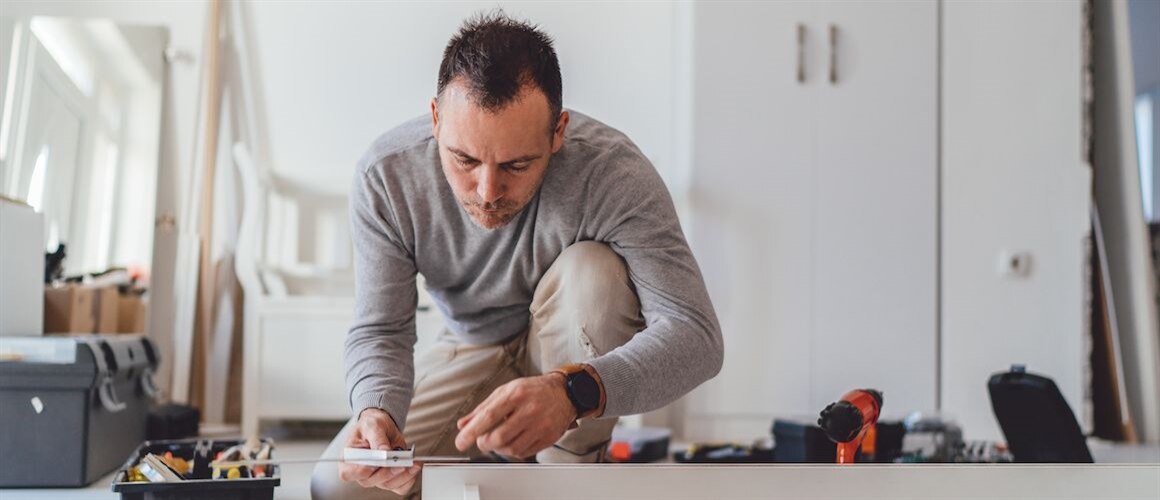
How To Assemble A Basic Tool Kit For Your First Home
3-Minute ReadUPDATED: June 06, 2022
As you step into homeownership, you may inherit some basic projects around the house. Even if you avoided buying a fixer-upper, chances are that you’ll need to undertake some DIY projects at some point.
Since you can no longer call your landlord to take care of a maintenance issue, it is a good idea to have a well-equipped household tool kit on hand. You’ll be able to jump into a project quickly without making a trip to the hardware store.
What Should Be In A Household Tool Kit?
When you start to build your household tool kit, it’s important to stick to the basics. Otherwise, you could have an overflow of tools in the garage with no useful purpose in sight. But, it’s a good idea to have a set of tools that could tackle a range of DIY home projects for beginners.
The first tools you should consider include a hammer, screwdrivers, a 25-foot tape measure, utility knife, pliers and a vise grip. With these in your toolbox, you’ll be well on your way to tackling any small issues that arise in your new home.
Let’s take a closer look at what else you should absolutely have in your toolbox.
A Tape Measure
Many projects around the house will start with whipping out your tape measure. With this simple tool, you’ll be able to better plan and prepare for the job at hand.
When you are shopping for a tape measure, consider getting a 25-foot option with a locking feature. Also, make sure that the tape measure itself is more than an inch wide. Otherwise, it’s easy to get frustrated with a floppy tape measure.
A smaller, portable tape measure may also come in handy. If, for example, you find a beautiful piece of furniture while thrift shopping, you can take measurements to confirm that it would fit in your space. This is especially important if you’re setting up a small living space.
A Hammer
A standard medium-size hammer should tackle most jobs around the house. If you’re undertaking more delicate jobs, then consider a smaller option. If possible, find a hammer with a cushioned grip. Your hands will thank you later!
A Screwdriver
With screwdrivers, you have several options. You can choose to buy a range of individual shapes and sizes. Or you can simply buy a screwdriver with interchangeable tips. The choice is up to you and will depend on the space you have available.
A Utility Knife
A utility knife is a useful tool to have around. You never know what you’ll run into, but a utility blade can usually help with the job.
An Adjustable Wrench
Although you could buy a set of combination wrenches, an adjustable wrench will work well for most households. You can always upgrade to the combination wrenches if the need arises. However, you should accomplish most tasks with the adjustable option.
A Putty Knife
With a putty knife, you can fill in any holes in the wall without leaving an eyesore behind. Beyond patching up holes, you can also use this tool to help remove paint.
A Flashlight
Often repairs need to happen in dark corners. A small flashlight will likely come in handy at some point. You could also invest in an affordable headlamp to avoid the inconvenience of holding onto your flashlight while trying to tackle a project.
Sandpaper
A little bit of sandpaper can go a long way. Throw some in your toolbox for when the occasion arises. You’ll be happy that you don’t need to make a trip to the store for a sheet of sandpaper.
A Level
A level can help in a wide range of projects. You can use it to hang pictures perfectly, mount shelves without a tilt, and even flooring accurately. Be sure to check the accuracy of the level before you leave the store. You can double-check by comparing your level to one of the professional-grade options in the store.
Vise Grip Pliers
These pliers will be able to double as a small vise that can hold things in place. You will appreciate the slip-free grip when you encounter a sticky screw or a wet surface. It can be especially useful during a bathroom remodel.
Moving Beyond The Basics
As you foray further into homeownership, you may get more comfortable tackling DIY projects. At that point, you should consider buying more specialized tools on an as-needed basis. For example, if you decide to tackle a spring home project or kitchen remodel, then you’ll probably need more than a basic toolbox.
Don’t be afraid to try out new DIY home improvement ideas. You might love the end result!
How To Amass Your Tools Without Breaking The Bank
Buying quality tools can be an expensive undertaking. Luckily, there are a few ways to cut costs.
If you’re only planning to use a tool one time, then explore renting instead of buying. That could save you the upfront cost and the hassle of storing a major tool later on. If you’re planning to buy, then check out sales and tool shops for refurbished tool options. Another option is to seek out a tool library that could save you thousands.
Final Thoughts
A well-stocked toolbox will help you tackle many small home improvement projects. For larger projects, you may need to consider hiring a contractor. If things turn out more expensive than you anticipated, then consider a home improvement personal loan to help you finish your project quickly.
Working On A Home Project?
Use a personal loan to finance exactly what's needed for turning your house into a home.
See My OffersRelated Resources
Viewing 1 - 3 of 3

